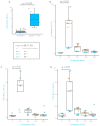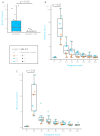Breath-Taking Perspectives and Preliminary Data toward Early Detection of Chronic Liver Diseases
- PMID: 34829792
- PMCID: PMC8615034
- DOI: 10.3390/biomedicines9111563
Breath-Taking Perspectives and Preliminary Data toward Early Detection of Chronic Liver Diseases
Abstract
The gold standard method for chronic liver diseases diagnosis and staging remains liver biopsy, despite the spread of less invasive surrogate modalities based on imaging and blood biomarkers. Still, more than 50% of chronic liver disease cases are detected at later stages when patients exhibit episodes of liver decompensation. Breath analysis represents an attractive means for the development of non-invasive tests for several pathologies, including chronic liver diseases. In this perspective review, we summarize the main findings of studies that compared the breath of patients with chronic liver diseases against that of control subjects and found candidate biomarkers for a potential breath test. Interestingly, identified compounds with best classification performance are of exogenous origin and used as flavoring agents in food. Therefore, random dietary exposure of the general population to these compounds prevents the establishment of threshold levels for the identification of disease subjects. To overcome this limitation, we propose the exogenous volatile organic compounds (EVOCs) probe approach, where one or multiple of these flavoring agent(s) are administered at a standard dose and liver dysfunction associated with chronic liver diseases is evaluated as a washout of ingested compound(s). We report preliminary results in healthy subjects in support of the potential of the EVOC Probe approach.
Keywords: breath biopsy; chronic liver diseases; volatile organic compounds (VOC).
Conflict of interest statement
All the authors are employees of Owlstone Medical Ltd.
Figures



References
-
- Holzhutter H.G., Wuensch T., Gajowski R., Berndt N., Bulik S., Meierhofer D., Stockmann M. A novel variant of the (13)c-methacetin liver function breath test that eliminates the confounding effect of individual differences in systemic co2 kinetics. Arch. Toxicol. 2020;94:401–415. doi: 10.1007/s00204-020-02654-0. - DOI - PubMed
-
- GBD-Cirrhosis-Collaborators The global, regional, and national burden of cirrhosis by cause in 195 countries and territories, 1990–2017: A systematic analysis for the global burden of disease study 2017. Lancet Gastroenterol. Hepatol. 2020;5:245–266. doi: 10.1016/S2468-1253(19)30349-8. - DOI - PMC - PubMed
Publication types
LinkOut - more resources
Full Text Sources

